Everywhere you look these days, more and more advertisers are discussing Artificial Intelligence (AI) and automatic testing being used to expedite and make our jobs easier. From machine learning to Dynamic assets serving the best creative to the best audience and more — automated testing and platform automation are on the rise in the advertising industry.
Automated optimizations started on Facebook with simple dynamic creatives and copy, allowing the algorithm to tailor ads to each person, creating the perfect combination of creative and copy to get that person to convert.

We’ve seen success with such features, and that sort of automation has now evolved into Standard Enhancements on Facebook. Now, with the simple switch of a button, Facebook will enhance an ad to its best ability (which is up for debate) to create the perfect ad that your audience is most likely to respond to.

On top of that, Google has been a pioneer in AI for some time now with its Smart Bidding and Performance Max features. These features combine Google’s AI technologies with machine learning algorithms that factor in a large number of parameters beyond what normal digital advertisers can do.
“Performance Max combines Google’s AI technologies across bidding, budget optimization, audiences, creatives, attribution, and more. They’re all empowered by your specific advertising objective, for example, if you have a CPA or ROAS target, and the creative assets, audience signals, and optional data feeds you provide.”
While all of these factors can be taken into consideration by a digital advertiser, Google’s AI has the ability to pull these attributes in real time, allowing search campaigns to be optimized quicker.
And automated optimizations won’t stop there. Those are just two examples of current AI capabilities, and there is no telling how far AI will be able to go in the future.
As we learn more about our audiences and how the algorithm works with AI to serve our ads to those audiences, automated optimizations will only become more sophisticated. It is our job as advertisers to learn these artificial intelligence systems as well as we can, so as they develop, we are developing right alongside them.
Enter ChatGPT, the AI tool sweeping the advertising world off its feet. This bot’s ability to do a plethora of tasks such as writing copy, generating a year’s worth of social content, and even pass a law exam has us all interested and taking a closer look. ChatGPT has the fastest-growing user base, reaching 100 million monthly active users in January 2023, just two months after the platform’s launch. Now, ChatGPT sees 60 million daily active users.
Advertisers were some of the first users to jump on board and dive into everything the platform has to offer. Advertisers took the platform’s ability to generate near-perfect copy and ran with it, experimenting and testing the AI’s capabilities and pushing it to its limits. On top of that, some account managers even started using the program to generate negative keyword lists and targeting options to tap into new audiences. ChatGPT can also help structure campaigns, write code and compose complex spreadsheet formulas – all time-consuming tasks that most of us want to save time doing. And now we can.
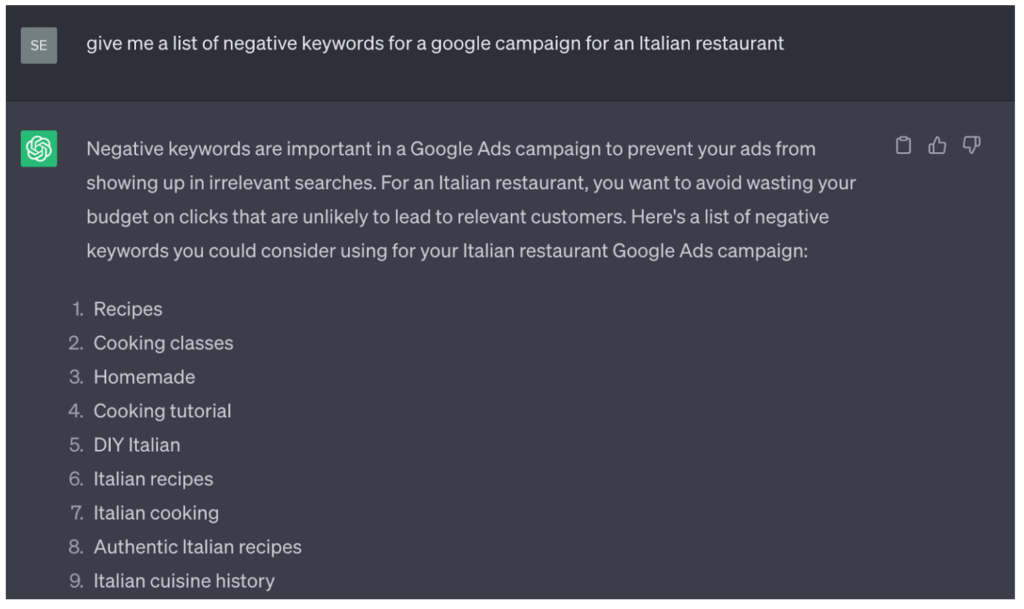
Need some ideas on how to use AI in your day-to-day? Search Engine Journal composed an article of 25 examples advertisers can use ChatGPT to streamline or jumpstart everyday tasks, making the day-to-day life of an advertiser easier than ever.
Innovation is great and something that every advertiser should be able to embrace in our fast-paced industry, but there has already been a rise in issues and weariness when it comes to being too reliant on artificial intelligence.
The first major example is the use of Midjourney to create AI-generated images, whether they be used for personal enjoyment or for creative assets for advertising campaigns. The use of AI to create images thrusts us into a legal gray area. The only way AI knows how to create these images or copy based on a simple prompt is to scour the internet for similar keywords or images tied to the words used in your prompt. The bot then scrambles up the information it found, and spits out “new” information back to you. And voila! Beautiful copy and creative right at your fingertips in a matter of seconds.
While these tools are great and fun to use, many artists have expressed their issues with the likes of Midjourney, for the tool is taught to create its mind-bending images by using the intellectual property of others without permission. The founder of Midjourney even admitted that the program was taught with millions of copyrighted images found on the internet.
As you can see above in the illustration provided by Creativeindie, there is a stark difference between referencing art and sampling it.
AI will continue to advance and creatives made with machines and other artificial intelligence programs become harder to detect. It is up to both advertisers and consumers to educate themselves on what is what and to not forget that without the humans, these programs would not exist in the first place.
At this point, many people can tell the difference between a human-drawn image and an AI-generated one, and it’s only a matter of time before consumers can tell the difference between AI-generated copy and content and human-generated copy and content.
“ChatGPT also has limits for making content from scratch: while it can pull together and compile information that already exists, it can’t generate new ideas that are the lifeblood of strong marketing campaigns.” Source.
AI uses data and specific instructions to generate content based on prompts. AI-based technologies can only produce from what they are fed or what they can find on the internet depending on how the AI is set up to operate. As humans, we have the ability to pull from experiences, memories, or knowledge that are individualistic to us. Being able to use our unique experiences in the process of creating advertising and marketing campaigns gives us a competitive edge over AI.
For example, time-sensitive topics like memes, trends, and cultural references move at the speed of light. You might fall short if you depend on AI to generate copy ideas but want to stay relevant with up-to-date cultural references. AI-generated content can only pull from what it is fed and already knows, not what is currently happening.
ChatGPT is only trained with data up until September 2021, so the information we get from the platform can be outdated and incorrect, especially when it comes to information regarding marketing and advertising trends and tools.
When asked about breaking news and current trends, ChatGPT replied about its lack of current events and provided other resources to find the information.
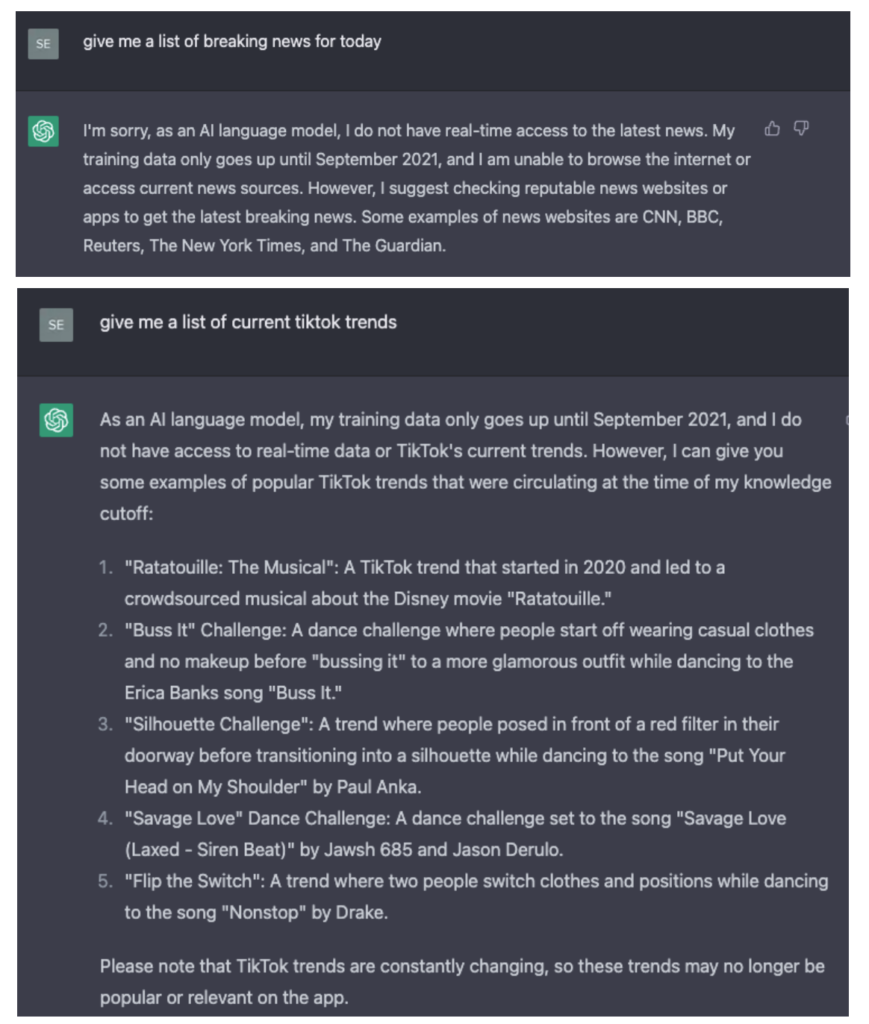
So, while it is prevalent that AI has its limitations and can’t do everything, by combining our knowledge with the aid of AI technology, advertisers will be able to jumpstart any project or creative process effortlessly. The best thing we can do right now is to learn about AI and understand how it works. Knowing what prompts to input into ChatGPT and other AI tools is the first step in optimizing workflows and jumpstarting creative processes with these technologies.
AI will continue to jumpstart our creative process when brainstorming copy, creatives, keywords, and more. It’s a tool all creatives should become familiar with and take advantage of when needed. With human supervision, AI will continue to improve its abilities and perform in an ethical way. On those days when your creative brain just won’t turn on, we can rely on AI to get the gears turning but don’t let the robots take your creative spark.
The number of opportunities for AI in the advertising world is endless. only a matter of time before the role of an advertiser will change to make sure these tools operate and are leveraged in the right way – in some cases, it already is. We as humans must be responsible for feeding these tools correct and ethical information and give credit where it is due.
Our world and industry are constantly changing, and if we push against the reliance on machines and AI, we might be left in the dust. Innovation requires adjustment, and if anyone lives by that statement, it’s advertisers.
All the latest digital advertising tips and industry insights delivered to your inbox every quarter
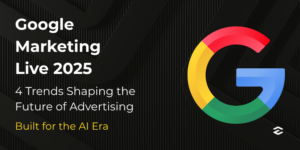
Google is doubling down on AI-first advertising strategies in 2025. Here are the four trends from Google Marketing Live that advertisers must act on.
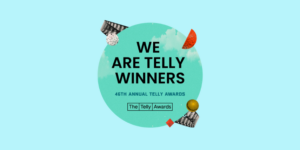
Closed Loop and Clover earned three Silver Telly Awards for the “Behind the Business” campaign, celebrating standout creative across CTV and digital.
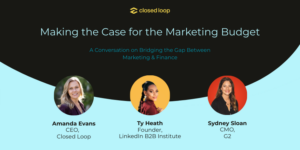
Learn how leading CMOs are reframing marketing to speak the CFO’s language, drive predictable outcomes, and secure their budgets in 2025 and beyond.